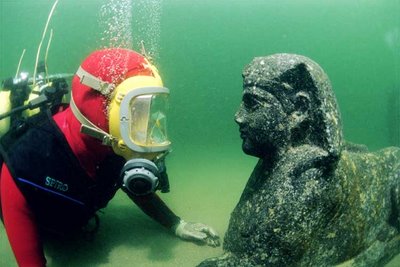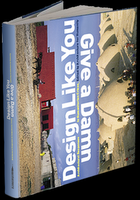And: Best line from the New York Times Magazine's profile of doomcore-trance band SUNN0)), by Greg Anderson, one half of the robe-wearing, fog-lurking metalhead duo that's been playing the Knitting Factory and the Walker: "Steve's the arty guy in the band. I'm the guy that likes to stay home and watch 'Seinfeld.'"
5.31.2006
Lo-fi metal map
And: Best line from the New York Times Magazine's profile of doomcore-trance band SUNN0)), by Greg Anderson, one half of the robe-wearing, fog-lurking metalhead duo that's been playing the Knitting Factory and the Walker: "Steve's the arty guy in the band. I'm the guy that likes to stay home and watch 'Seinfeld.'"
DIY miracle
 As a longtime food-miracle chronicler, this makes the Jesus-on-toast experience available to all--for just $29.99. The Jesus Pan, for faith and profit.
As a longtime food-miracle chronicler, this makes the Jesus-on-toast experience available to all--for just $29.99. The Jesus Pan, for faith and profit.Speaking of miracles: Pat Robertson says he can leg press 2,000 pounds, thanks to his patented protein shake. Trouble is, the world-record leg press is 665 pounds, and the guy who earned the distinction burst the capillaries in his eyeballs doing it.
5.27.2006
5.26.2006
Why can't we all get along?
 Republicans/Democrats, Sunnis/Shiites, black/white, Americans/the rest of the world: we all oughta take a lesson from the animal kingdom. A mother lion in captivity gave birth to three premature cubs, but due to low birth weight they all died. When the mother's health started drastically declining due, most likely, to depression, the zoo lined her up with the only orphans they could find--a batch of piglets, cleverly disguised as tiger cubs. [via eyebeam]
Republicans/Democrats, Sunnis/Shiites, black/white, Americans/the rest of the world: we all oughta take a lesson from the animal kingdom. A mother lion in captivity gave birth to three premature cubs, but due to low birth weight they all died. When the mother's health started drastically declining due, most likely, to depression, the zoo lined her up with the only orphans they could find--a batch of piglets, cleverly disguised as tiger cubs. [via eyebeam]And in Germany, a swan demonstrates that love knows no bounds: a black swan in Muenster has reportedly fallen in love with a white, swan-shaped paddleboat many times its size.
How Jenna's boyfriend got into Harvard.
 How does a college dropout get into Harvard Business School?
How does a college dropout get into Harvard Business School? By carrying the president's Altoids:
A 26-year-old college dropout who carries President Bush’s breath mints and makes him peanut butter-and-jelly sandwiches will follow in his boss’s footsteps this fall when he enrolls at Harvard Business School (HBS).Among the high points of Gottesman's CV are one year at Claremont-McKenna College, experience as an aide to Andy Card and personal assistant to Bush, and... having dated Jenna Bush ten years ago. His duties today range "from dog-sitting the president’s Scottish terriers, Barney and Miss Beazley, to carrying the president’s speeches and giving him the 'two-minute warning' before a speech begins."
Though it is rare for HBS—or any other professional or graduate school—to admit a student who does not have an undergraduate degree, admissions officers made an exception for Blake Gottesman, who for four years has served as special assistant and personal aide to Bush...
RIP Desmond Dekker
 Reggae and ska great Desmond Dekker, born Desmond Adolphus Dacres in Kingston, died of a heart attack Wednesday night at age 64. The first Jamaican artist to have an international hit, he was considered the island's first reggae legend. "When he released 'Israelites' nobody had heard of Bob Marley," says his manager, Delroy Williams. "He paved the way for all of them."
Reggae and ska great Desmond Dekker, born Desmond Adolphus Dacres in Kingston, died of a heart attack Wednesday night at age 64. The first Jamaican artist to have an international hit, he was considered the island's first reggae legend. "When he released 'Israelites' nobody had heard of Bob Marley," says his manager, Delroy Williams. "He paved the way for all of them."Photo: David Jiro
5.24.2006
"Bring back Dada!"
 Charles Marowitz on the Nationial Gallery of Art's Dada exhibition:
Charles Marowitz on the Nationial Gallery of Art's Dada exhibition:We, in the morass of Iraq, daily toting up fatalities and reeling from internecine strife in the Middle East and bitter divisions in our own country, are living in Dadaist times -- except there are no Dadaists around to express our anger and frustration. Instead, we studiously chronicle the atrocities and then "op-ed" them to death. Our films routinely reproduce the sadism, violence, and terror which are the basic preoccupations of our era; our theatre companies churn out documentaries of the appalling events which disturb our "domestic tranquility"; our media-mavens regularly dispense moral indignation and expose the corruptions of which every day brings us some new and grotesque installment. Our dissent is civilized and law-abiding; our demonstrations orderly and "peaceful," our wrath bitterly suppressed.Via Cursor.
"Milton thou shouldst be living at this hour" is a cry that should be replaced by "Tzara, thou shouldst be living at this hour!" Where is the renegade art that should decry the lunacy of these renegade times? The artists are as silent as the students, the students as comatose as their parents. Dissent has had to "make do" with nuanced perceptions of injustice and gentle knuckle-wrapping of criminal leaders like Bush, Blair, Putin, and Ahmadinejad, thieving lobbyists, corporate embezzlers, and ghoulish, puritanical, smug and well-placed church-going neocons.
What established American artist today would dare to paint a moustache and goatee on the Mona Lisa, smash out George Washington's wooden teeth, or show Thomas Jefferson copulating with Sally Hemings? No, we content ourselves with the satirical barbs of Jon Stewart and Stephen Colbert, Jay Leno and David Letterman; revel in comic aperçus which show that we Americans can "let our hair down" as well as the next man, "kid" our leaders and "send up" our congressmen. All we seem unable to do is counter the transgressions of our faltering democracy or find candidates without Achilles' heels to elect.
Moral disgust is precisely what engendered the spirit of Dada. Bring back Dada say I!
5.23.2006
Building an elephant-proof house
 I wrote a short piece for the Twin Cities' monthly The Rake on Cameron Sinclair of Architecture for Humanity. It starts out like this:
I wrote a short piece for the Twin Cities' monthly The Rake on Cameron Sinclair of Architecture for Humanity. It starts out like this:Humanitarian architecture: On the glamour meter, the term is right up there with “FEMA trailer.” But during a recent discussion on the topic at a noisy Dinkytown bar, my ears perked up when an “elephant migration specialist” was listed along with soil engineers, architects, and government officials as a crucial collaborator on a relief project in a tsunami-struck Sri Lankan village. Cameron Sinclair, who had just finished a semester as a visiting professor at the U of M, was talking about how designers were granted permission to rebuild several buildings on a vacant lot.Read the whole thing.
But after meeting with community members, they learned why the lot had stood empty so long: “It was on a migrational route for elephants, and when elephants get really tired, they lean against trees and fall asleep ... They lean on poorly built houses and then the houses collapse.”
The housing was built elsewhere.
While perhaps not truly glamorous, this bit of trivia does offer a glimpse into Sinclair’s work as humanitarian architecture’s foremost advocate...
5.22.2006
Buying overconsumption?
 Sarah at Inhabitat:
Sarah at Inhabitat:Danish designer, Mads Hagstrom, director of The FLOWInstitute at Dansk Design Centre, brought a show-stopping installation to ICFF [the International Contemporary Furniture Fair]. FlowMarket sits in the middle of the exhibit floor, enclosed in a sheer white curtain. The booth is set up as a store, but the products on the shelves are empty containers with generic labels addressing the plagues of consumer culture.
Plastic drink bottles read “Clean Tap Water”; Spam-like tins say “100% GMO”; a cold case contains aluminum soda cans labeled “Renewable Energy”; rows of pill bottles say “Valuebased Consumption.” It’s a powerful space - clean and white - with a hanging poster in the middle quoting our friend, Anna Lappe: “Every time you spend money, you’re casting a vote for the kind of world you want.”
What’s a little disconcerting is that this booth isn’t just set up as a store, it is one. You can buy everything you see.
And people were buying! Granted, like a gift shop in a museum, the items you can pick up at FlowMarket are low-cost compared to the pricey, high-design items on display throughout the rest of the building. They are takeaways that act as little reminders of the show, and of they wheel of consumerism we’re all spinning.
Nevertheless, I wonder how the designer reconciles selling disposable packaging as a means of criticizing overconsumption.
e-tuktuk
The E-Tuktuk contains a laptop computer, battery operated printer, camera, telephone and scanner. Internet access is provided via a CDMA-enabled wireless connection, and electricity is provided via a generator. A roof rack allows the vehicle to carry other equipment such as the KCR's mobile broadcasting unit.As UNESCO writes, e-tuktuk can reach geographically isolated areas of the Kothmale region, but its goal is to bridge more than geography: KCR seeks to engage those marginalized due to caste, race, gender, and, presumably, education and economics. And by bringing such technology to the people, it makes it less daunting.
Radio programmes are narrowcast via two loud speakers mounted to the roof rack. The speaker system is used to announce the telecentre's presence when it arrives in a village or designated location. The weekly route of the E-tuktuk is broadcast over the radio to inform listeners about the location and time that it will arrive in their community.
“Lots of people in this area don’t even know what the internet is. I think the etuktuk is a really good way to introduce and improve our knowledge about information technology and the narrowcasting gives a voice to local people and all of us in the community,” says Buddhika Darshana of Kothmale CMC.
Via SmartMobs.
5.21.2006
Framing the border.
 For the Border Film Project, William Howard distributed 100 disposable cameras to minutemen and migrants along the Mexico border. For a project in Polar Inertia, Howard offers his own timely take on the demarcation line between the US and Mexico. "As I photographed the border from the Mexican side I tried to imagine how it must look to immigrants from the south, arriving there for the first time and being able to peer beyond the walls into the United States. What are their hopes and expectations?"
For the Border Film Project, William Howard distributed 100 disposable cameras to minutemen and migrants along the Mexico border. For a project in Polar Inertia, Howard offers his own timely take on the demarcation line between the US and Mexico. "As I photographed the border from the Mexican side I tried to imagine how it must look to immigrants from the south, arriving there for the first time and being able to peer beyond the walls into the United States. What are their hopes and expectations?"
Bastard chairs
 Another great project from Michael Wolf is his Bastard Chairs series featuring a range of outcast, modified, and otherwise tricked-out chairs from his travels around the world.
Another great project from Michael Wolf is his Bastard Chairs series featuring a range of outcast, modified, and otherwise tricked-out chairs from his travels around the world.
100 x 100
Photographer Michael Wolf photographed 100 residents of Hong Kong's oldest public housing complex. While the rooms are identical 10 x 10 boxes, the variations seem endless.





Dodo stamps.
 Pib Burns' fascinating homepage covers topics like cryptozoology and astronomical catastrophism, but I especially like his collection of dodo-themed postage stamps. While the birds have been extinct since 1681, they're the continuing source of fascination by stamp collectors and explorers alike (William Gibbons, upon hearing rumors that dodos were spotted in the island of Maritius in the Indian Ocean, mounted an unsuccessful expedition there in the 1990s). Marituius, Laos, Cuba, and Micronesia have all produced commemorative stamps.
Pib Burns' fascinating homepage covers topics like cryptozoology and astronomical catastrophism, but I especially like his collection of dodo-themed postage stamps. While the birds have been extinct since 1681, they're the continuing source of fascination by stamp collectors and explorers alike (William Gibbons, upon hearing rumors that dodos were spotted in the island of Maritius in the Indian Ocean, mounted an unsuccessful expedition there in the 1990s). Marituius, Laos, Cuba, and Micronesia have all produced commemorative stamps.
5.20.2006
The question.
Free Republic: PEACE rally is "hate parade"
Last night, the PEACE Foundation held a rally here in North Minneapolis: 1500 people linked hands the length of 26th Avenue, one of the roughest streets in this very poor, mostly black neighborhood, as a symbol of solidarity and a commitment to nonviolence. As the rally was going on, a kid was shot in the back a block away.
How do the rightwingers at the Free Republic interpret this sad story? As a "hate rally." Assuming such a gathering must be an antiwar rally, one commenter wrote:
How do the rightwingers at the Free Republic interpret this sad story? As a "hate rally." Assuming such a gathering must be an antiwar rally, one commenter wrote:
There haven't been any "Peace Rallies" in this country in years.Others joked that the victim, a 16-year old boy, must've been carrying a "God Bless Our Troops" sign. PEACE stands for Public Engagement and Community Empowerment and is dedicated to curbing the violence in this neighborhood that claims a life nearly every other week.
They're all "Hate Parades" for people smart enough to walk but too stupid to bath [sic].
5.19.2006
The Clean Hub
5.18.2006
Graphic Design Dos and Don'ts
 I think this would fall under "Don't." (For a craft magazine called Butterick, via Design Observer.)
I think this would fall under "Don't." (For a craft magazine called Butterick, via Design Observer.)
5.17.2006
DNR not GNR
5.16.2006
Holy mischief in an age of fast faith
 When Aiden Enns left his job as managing editor at Adbusters after several years, it's no surprise what this journalist, BuyNothing Christmas.org founder, and practicing Mennonite did next: he started publishing a new magazine on faith, activism, and progressive change called Geez. In a recent email interview, he discussed a magazine that takes to heart advice he got from an activist theologian years ago: "Have one foot in the church and one outside. And keep your weight on the one outside."
When Aiden Enns left his job as managing editor at Adbusters after several years, it's no surprise what this journalist, BuyNothing Christmas.org founder, and practicing Mennonite did next: he started publishing a new magazine on faith, activism, and progressive change called Geez. In a recent email interview, he discussed a magazine that takes to heart advice he got from an activist theologian years ago: "Have one foot in the church and one outside. And keep your weight on the one outside."A few weeks ago, a group of American Christians held prayer rallies at gas stations to, presumably, urge God to help lower gas prices. Obviously, there are real problems with this from a perspective that truthfully emulates the teachings and behaviors of Christ. But how is this story emblematic of the kind Christianity Geez was founded as an alternative to?
Hmm, Christians praying to God for lower gas prices? Yikes, that confirms it... the oil barons really are God!
Praying for better deals at the pump? This is a part of conservative Christianity I don't understand -- it encourages selfishness and operates from a mechanistic world view. If God is some sci-fi robot that blesses us when we utter the magic password, then sure, it makes sense to pray for lower gas prices.
But if we are oriented to caring for others, and operate from an enchanted, mystical world view, then rising gas prices do something different to my spirit. They remind me of our profound interconnection, and get me thinking of limits and responsibility.
And then I pray for wisdom to know how to downscale and handle the conflict. I guess this is partly why Geez exists.
Each of us at Geez magazine has our own reasons for starting with the project. For me, I'm excited about a social and political dimension to the gospel. It's easy to fret over my connection to all the problems in the world. So I'm looking for stories that unravel the complicity and show paths of hope.
"Be anything you like, be madmen, drunks, and bastards of every shape and form, but at all costs avoid one thing: success."My first reaction to Geez is that it's similar in tone and design to Adbusters: against mindless consumerism, designed with a similar kind of DIY aesthetic, interested in reclaiming core values that can be obscured by the relentless pursuit of the American dream. As a past editor at Adbusters, how was Geez inspired by that magazine, and how is Geez improving upon it?
—Thomas Merton
I had come to Adbusters after eight years as a journalist and editor with a national church paper (Canadian Mennonite). In Vancouver, at Adbusters, I found my faith newly enlived. I saw our venture as prophetic - in the sense that Jesus said woe to those who are rich and the Hebrew prophets cried foul in defense of widows, orphans and forests. Adbusters offers a deep critique of the wide eyes and stone hearts that fortify consumerism.
I left Adbusters to see if this socially-engaged, prophetic critique might fly with people in the radical faith community. A couple years later, thanks to a solid group of volunteers, Geez was born. Adbusters is a kindred spirit and constant point of reference.
Will we improve upon Adbusters? Uh, that's a little presumptuous... but it's helpful to set high goals. Adbusters is a good rant. I'd like Geez to be a rant plus a gentle corrective. Criticize but also nurture an alternative community that embodies more hopeful, more helpful ways to live and feel. It's mushy gushy to talk about religious things. But someone, I think, has to articulate that wonderful feeling that comes from staring at a tree, say a weeping willow with its branches stroking the grass. That feeling of infinity that comes from a river that ripples and flows. This sense of awe has a political dimension, I want to articulate that and help it birth a more sustainable social movement.
My second reaction was surprise at the irreverence. In among quotes by Meister Eckhart and thoughtful essays on family values and life at a Trappist monastery are photos of a tattooed punk girl flipping off the camera; your hacked-up, newly logoless bible; and profiles of illegal art studio squatters. How do you respond to critics who say you're too negative, too un-Christ-like with your content? (I recall a few letters to the editor even took issue with the title, Geez being a truncation of Jesus' name and long ago used as a curseword.)
"I don't really know what fascism is, but this mixture of religion and military, this full-on blessing of the indiscriminate evils of war is, let's just say, offensive to the gentle spirit of Christ and Gandhi in me."I'm angry at Zondervan, who claims to be the largest publisher of Bibles, at selling out to Rupert Murdoch's News Corporation. We're all screwed when we take our sacred writings and hand them over to profiteers to re-package and sell back to us again and again (rant for ten minutes). I'm angry at Billy Graham's organization for coordinating prayers for the troops in Iraq (Operation Bless Our Troops), giving dog tags to civilians with prayers on them when they donate 10 dollars or more. I don't really know what fascism is, but this mixture of religion and military, this full-on blessing of the indiscriminate evils of war is, let's just say, offensive to the gentle spirit of Christ and Gandhi in me. That said, we need to find a creative, even redemptive, way of expressing this outrage. Hence we "circumcize our scriptures," and excise the Zondervan brand from the spine of our Bibles.
—Aiden Enns
Back to basics: how'd this magazine come to be? In times where the radically religious are garnering headlines, from Bush and bin Laden to the Phelps family whose website godhatesfags.com pretty much sums up their beliefs, it's good timing.
Utne magazine was born in an era of increasing right-winged-ness (1984). With Reagan and Thatcher wielding their conservative politics, the progressives on the left needed a voice and Utne flashed on the scene.
Same with Geez, it seems to me. With Bush's re-election, stadium churches and "Christian" attached to seemingly everything (including capitalism and war), a whole subgroup is yearning for a voice to disagree. The message of gentleness, love, hospitality and common good is lost among a false-gospel of self-reliance and apocalyptic entitlement (not sure what that means, but it sounds good; sort of like manifest destiny for Left Behind readers).
And the response has been tremendous. We're up to about 1300 subscriptions with no promo budget. And it feels like we're just getting started.
Issue Two quotes Trappist monk Thomas Merton, a hero of mine: "Be anything you like, be madmen, drunks, and bastards of every shape and form, but at all costs avoid one thing: success." While the quote seems to sum up the reverence/irreverence balance mentioned above, I've gotta ask: how will you gauge Geez's success?
In my mind, Geez will be successful if it does any of the following: give me and my friends a meaningful non-profit project to work on; rattle the cage of the religious right and tease out a few vulnerable souls trapped among the platitudes (okay, I'll admit we have our own set of platitudes, but I really do think almost everyone should get out of the car and ride a bike!); inspire people to make concrete changes in their lives, changes that lead to smaller-scale, slower-paced and nature-based living; bring hope amidst despair, especially to people on the fringes of North American society.
Who do you imagine the reader of Geez to be? The contemplative who likes good beer and tells the occasional fart joke?
I'd like to meet more contemplatives who tell jokes. They probably don't need Geez.
Who are our readers? According to letters we've received, Geez is perfect for progressive clergy struggling in the suburbs. It's for non-religious daughters to give to their mothers preparing for ministry in the United church, and who read it when they go home to visit. It's for gay sons who come out to dads who respond by giving them Christian literature with only one perspective on sexuality, love and justice. It's for agnostics with radio stations, listening for friendly voices among a chorus of mostly judgemental Christians. Our tagline is "holy mischief in an age of fast faith." There's a demographic implied there as well.
5.15.2006
On curiosity.
"Curiosity implies a certain immoderation, a certain necessary excess. That is precisely what makes it a passion: it is amoral and follows its own laws, which is why society insists on taming it in various ways."
—Helga Nowotny, "The Dilemma of Curiosity and Its Use"
Via Speak Up.
—Helga Nowotny, "The Dilemma of Curiosity and Its Use"
Via Speak Up.
street robot
Seen on a power box outside the Walker Art Center:

The Smiling Bridge: And, in Wales, a project by the artist Virus puts a huge smile under the highest bridge over the Teifi River.
The Smiling Bridge: And, in Wales, a project by the artist Virus puts a huge smile under the highest bridge over the Teifi River.
"Veejaying."
Pasta&Vinegar points out an interesting story on the rise of "veejaying"--live translation of foreign films--in Uganda:
"Veejaying" is now a central form of local entertainment. But the art involves much more than translation. Part sports announcer, part street preacher, part comedian, a veejay must fill in cultural gaps and keep the audience engaged, which - for many veejays - often means taking considerable creative license.
The video jockey is an offshoot of the distinctly home-grown phenomenon of the video hall. Makeshift shacks commonly made of plywood and tin sheeting, they function as the main form of cinema for the Ugandan masses, most of whom cannot afford theater tickets or rentals of pirated DVDs.
Video halls mushroomed around the country in the mid-1980s, when a measure of relative peace and prosperity made copies of foreign movies more accessible. But since most of their patrons did not speak English well, owners brought in translators, who usually sat near the TV set, ideally with a microphone.
5.14.2006
Monday night lineup
 With Rove, Foggo, Cheney, Libby, Cunningham, DeLay, Abramoff, Ney, and so many other Republicans indicted or otherwise ensnared in legal proceedings, this Fox teaser for tomorrow night's lineup has me wondering: which is funnier, the president's speech followed by Prison Break, or the fact that viewer discretion is advised?
With Rove, Foggo, Cheney, Libby, Cunningham, DeLay, Abramoff, Ney, and so many other Republicans indicted or otherwise ensnared in legal proceedings, this Fox teaser for tomorrow night's lineup has me wondering: which is funnier, the president's speech followed by Prison Break, or the fact that viewer discretion is advised?More on the GOP's culture of corruption at WikithePresidency.
5.13.2006
Brazilian Stonehenge, Alexandria Exposed
 The BBC reports that archeologists in the northern Brazilian state of Amapa have discovered a field of 2000-year old Stonehenge-like structure. Made from 127 evenly spaced stones, the discovery is thought to be an ancient place of worship or an astronomical observatory.
The BBC reports that archeologists in the northern Brazilian state of Amapa have discovered a field of 2000-year old Stonehenge-like structure. Made from 127 evenly spaced stones, the discovery is thought to be an ancient place of worship or an astronomical observatory.And Berlin's Martin-Gropius-Bau is hosting what looks like a fascinating exhibition of artifacts from the sunken city of Alexandria, off the north coast of Africa. As Der Spiegel reports, the exhibition provides the backbone for the tawdry tales of deceit and betrayal by the likes of King Ptolemy XII (depicted as a sphynx in the statue below), who murdered his eldest daughter, and Ptolemy VIII, the "king had his own sons hacked to pieces and sent a trunk containing the remains to his wife."

5.11.2006
Rescripting architecture: A response to Irene Cheng
 “Are architecture and design really capable of 'solving' global, social and humanitarian crises? Or are such issues too complex to be fixed with simply another lighter, cheaper, emergency tent?” Peter Schmelzer, an architect who interviewed Architecture for Humanity's Cameron Sinclair with me recently, thinks these questions posed in Irene Cheng's review of Design Like You Give a Damn marginalize the work of architects. He posts an excellent response to the review and publishes a few new excerpts from our conversation with Sinclair. Please go read it all, but here are a few salient bits:
“Are architecture and design really capable of 'solving' global, social and humanitarian crises? Or are such issues too complex to be fixed with simply another lighter, cheaper, emergency tent?” Peter Schmelzer, an architect who interviewed Architecture for Humanity's Cameron Sinclair with me recently, thinks these questions posed in Irene Cheng's review of Design Like You Give a Damn marginalize the work of architects. He posts an excellent response to the review and publishes a few new excerpts from our conversation with Sinclair. Please go read it all, but here are a few salient bits:Sinclair’s comments suggest that the reviewer’s separationist view of architecture is inaccurate, and that the efforts of Architecture for Humanity do work toward solving social and humanitarian crises. For example, is providing meaningful work to local community members an architectural or design problem? No. But designing for and with the local people, using techniques and technologies that they can build themselves, to resist natural disasters in the future certainly is. And, by intent, it strengthens the local community on social, economic, and aesthetic levels while providing for basic needs.Earlier: Pragmatic Experimentation: An Interview with Cameron Sinclair
The reviewer goes on to lambaste AFH for backing away from a project due to limited resources rather than “any qualms about providing a humanitarian palliative to a military action of dubious ethical status.” I chuckle. For any organization, or those suffering from the results of military action, the “Can we do it” question has got to proceed the “Should we do it”. What point is there arguing ethics relative to a project that can’t be realized?
More from the reviewer: “Recent critiques levelled by Slavoj Zizek and others against human rights discourse might equally be applied to humanitarian design enterprises: by framing their task as a neutral matter of ameliorating suffering, they displace politics and a positive collective project of socio-political transformation.”
I can barely believe these words hit the blogosphere, given the politics that led up to the unpreparedness before and the mismanagement after the disaster in the Gulf Coast. We’ve been relying on politics, and they are simply not up to the task. How many disasters must people live and die through before we look for a better paradigm?
More from Cameron Sinclair:
There are two things we adhere to. One is that quiet change matters. So we don’t make a big deal out of it. And also, small projects can have really big impacts. We focus on very low-cost, small projects, not because we want to help one family, but we want to set a base to change policy. So if we can do a project that’s within budget, adheres to current guidelines, but challenges one or two of them—we build the project—then we can go to the government or to the local governing body and say, “Look, if you change your policy, you could affect the lives of millions of people. And here’s a project where we’ve solved your problem.” So we walk into the office with a solution, not a problem.
So, AFH has rescripted the architect from designing emergency shelters into a leader. A leader whose collaborative, technical, and creative skills inform politics and empower communities to improve themselves.
That’s of much more value than an stronger, cheaper emergency tent.
5.10.2006
Hayden/Goss, Merkel/Putin
Bush needs a new script. As Jon Stewart pointed out on The Daily Show (video), the president said almost exactly the same thing about his new nominee for CIA chief as he did about the guy who abruptly resigned.
Bush on Gen. Mike "Warrantless Wiretapping" Hayden: "He's the right man to lead the CIA at this critical moment in our nation's history."
Bush on Porter "Hookergate?" Goss: "He's the right man to lead this important agency at this critical moment in our nation's history."
It's not the first time, of course. Bush, who just said he "got a glimpse into [the] soul of conservative German leader Angela Merkel, said the same damn thing about autocratic Russian leader Vladmir Putin, a guy whose relations with the US have soured: "I was able to get a sense of his soul, a man deeply committed to his country and the best interests of his country."
Bush on Gen. Mike "Warrantless Wiretapping" Hayden: "He's the right man to lead the CIA at this critical moment in our nation's history."
Bush on Porter "Hookergate?" Goss: "He's the right man to lead this important agency at this critical moment in our nation's history."
It's not the first time, of course. Bush, who just said he "got a glimpse into [the] soul of conservative German leader Angela Merkel, said the same damn thing about autocratic Russian leader Vladmir Putin, a guy whose relations with the US have soured: "I was able to get a sense of his soul, a man deeply committed to his country and the best interests of his country."
RevoPower
 Several years ago, inventor Steve Katsaros started pondering how to come up with a new version of the fuel-powered bike:
Several years ago, inventor Steve Katsaros started pondering how to come up with a new version of the fuel-powered bike:So I thought to myself, “How do you power a bicycle with a clean gasoline engine?” I continued to think, “Would it is possible to design abicycle wheel with a gasoline engine built right into the wheel?” The trick was to have the entire engine, geartrain, starter, etc. be so thin that the whole assembly could spin between the forks of a standard bicycle. This spinning assembly (i.e. wheel with engine) could be cooled because it spins and not by a massive flywheel with a fan. In addition, I sought a solution that would allow anyone to install it on most bicycles and be easy to use.Coming off the production line in early 2007 will be the result of his experimentations, RevoPower, a gas-and-oil powered wheel that can be used to power an existing bicycle. A small motor within the wheel causes it to rotate on a fixed axle, but the engine only kicks in when the bikes speed is slower than the motor is traveling.
SurvivaBall: A "gated community for one"
 How will the effects of global warming hit the workforce--and profits? Preempting a work slowdown caused by "abrupt climate change," Halliburton (ok, The Yes Men masquerading as Halliburton officials at the May 9 Lexis-Nexis "Catastrophic Loss" conference) unveiled the SurvivaBall:
How will the effects of global warming hit the workforce--and profits? Preempting a work slowdown caused by "abrupt climate change," Halliburton (ok, The Yes Men masquerading as Halliburton officials at the May 9 Lexis-Nexis "Catastrophic Loss" conference) unveiled the SurvivaBall:The devices - looking like huge inflatable orbs - will include sophisticated communications systems, nutrient gathering capacities, onboard medical facilities, and a daunting defense infrastructure to ensure that the corporate mission will not go unfulfilled even when most human life is rendered impossible by catastrophes or the consequent epidemics and armed conflicts.See video and more photos of the conference here.
"It's essentially a gated community for one," said Wolf.
Dr. Northrop Goody, the head of Halliburton's Emergency Products Development Unit, showed diagrams and videos describing the SurvivaBall's many features. "Much as amoebas link up into slime molds when threatened, SurvivaBalls also fulfill a community function. After all, people need people," noted Goody as he showed an artist's rendition of numerous SurvivaBalls linking up to form a managerial aggregate with functional differentiation, metaphorically dancing through the streets of Houston, Texas.
The conference attendees peppered the duo with questions. One asked how the device would fare against terrorism, another whether the array of embedded technologies might make the unit too cumbersome; a third brought up the issue of the unit's cost feasibility. Wolf and Goody assured the audience that these problems and others were being addressed.
"The SurvivaBall builds on Halliburton's reputation as a disaster and conflict industry innovator," said Wolf. "Just as the Black Plague led to the Renaissance and the Great Deluge gave Noah a monopoly of the animals, so tomorrow's catastrophes could well lead to good - and industry must be ready to seize that good."
5.09.2006
Skull and Bones raided native graves
 According to Yale's alumni magazine, Prescott Bush along with other members of the Skull & Bones secret society, desecrated a grave thought to be that of the Apache leader Geronimo and stole his skull. A 1918 letter discovered in Yale archives lends credence to long-held rumors that Skull and Bones members broke into the grave. It reads, in part:
According to Yale's alumni magazine, Prescott Bush along with other members of the Skull & Bones secret society, desecrated a grave thought to be that of the Apache leader Geronimo and stole his skull. A 1918 letter discovered in Yale archives lends credence to long-held rumors that Skull and Bones members broke into the grave. It reads, in part:The skull of the worthy Geronimo the Terrible, exhumed from its tomb at Fort Sill by your club & the K -- t [Knight] Haffner, is now safe inside the T -- [Tomb] together with his well worn femurs[,] bit & saddle horn.
Is America pro-life?
American babies are three times more likely to die in the first month of life than an infant born in Japan, according to a survey by Save the Children. Only Latvia, with six infant deaths per 1,000, ranked worse than the US among developed countries in infant mortality. So much for the GOP's "culture of life."
Visible Earth
 Look here, a big picture of the Earth, apparently the most detailed ever. Thanks to NASA. (And while I'm at it, the USGS has a video of Mount Saint Helens' "fin.")
Look here, a big picture of the Earth, apparently the most detailed ever. Thanks to NASA. (And while I'm at it, the USGS has a video of Mount Saint Helens' "fin.")
Beyond the smiley face: World domination!
 Wal-Mart's efforts to trademark the yellow smiley face is just one more bit of evidence that the big-box retailer is trying to take over the world. Here's more: University of Minnesota economist Thomas Holmes has created an animation showing the spread of Wal-Mart--like an infectious disease--across America, from 1962 to 2004.
Wal-Mart's efforts to trademark the yellow smiley face is just one more bit of evidence that the big-box retailer is trying to take over the world. Here's more: University of Minnesota economist Thomas Holmes has created an animation showing the spread of Wal-Mart--like an infectious disease--across America, from 1962 to 2004.
Start seeing immigrants
More graffiti links.
Frieze reviews "Design Like You Give a Damn"
 Frieze magazine just reviewed Architecture for Humanity's new book Design Like You Give a Damn. After noting AFH's mission of "promoting architectural and design solutions to global, social and humanitarian crises," writer Irene Cheng asks:
Frieze magazine just reviewed Architecture for Humanity's new book Design Like You Give a Damn. After noting AFH's mission of "promoting architectural and design solutions to global, social and humanitarian crises," writer Irene Cheng asks:This description of the group’s aims begs the question: are architecture and design really capable of ‘solving’ global, social and humanitarian crises? Or are such issues too complex to be fixed with simply another lighter, cheaper, emergency tent?Cheng has just set up a nifty straw-man argument: by changing AFH's mission of "promoting... design solutions" to "'solv[ing]' social problems" (she adds quote marks to make it seem like the kind of legit citation it's not), she suggests that AFH co-founder Cameron Sinclair's ego is monstrous and that he believes that humanitarian architecture is a cure-alll for social problems. Linguistically, isn't "solving" qualitatively different from "promoting solutions"? One suggests a big fix--voila!--while the other admits multiple answers. A look at the book's outline--which covers housing and water, sanitation, energy, and community action--suggests that the 70-some featured projects don't claim to be a silver bullet.
(Thanks, Max.)
5.05.2006
5.04.2006
Linkroll.
Thanks to all who've linked to my interview with Architecture for Humanity's Cameron Sinclair: Inhabitat, Archinect, WorldChanging, Urbanism.org, and, of course, Vivus.
Update: Also, Northfield.org and things magazine.
Update: Also, Northfield.org and things magazine.
Mount St. Helen's "fin"
A spectacular new structure has formed inside the crater at Mount St. Helens, just in time for this weekend's opening of the Spirit Lake Highway.
A slab of rock the size of a football field is standing on end inside the crater.
The giant 'fin' is pushing upwards of four to five feet a day, but is not growing taller because it tends to crumble as it grows...
Guerrilla scrubbing.
 A stencil and a power washer sprayed this anti-pollution message on grimy Chicago sidewalks. Has anyone seen this idea used by non-institutional street artists?
A stencil and a power washer sprayed this anti-pollution message on grimy Chicago sidewalks. Has anyone seen this idea used by non-institutional street artists?
5.02.2006
Pragmatic Experimentation: An interview with Cameron Sinclair
 Nearly drowned out by the strains of Dookie-era Green Day and the Barenaked Ladies, three of us were at the table trying to talk: me; my brother Peter, a green designer and founder of Vivus Architecture; and the British-born founder of Architecture for Humanity, Cameron Sinclair. Designer of the Year nominee at the Design Museum in London, author of the new book Design Like You Give a Damn: Architectural Responses to Humanitarian Crises, and winner of prestigious $100K TED Prize, Sinclair met us at a sports bar near his Minneapolis hotel in the University of Minnesota's Dinkytown. "We’re in a college dive bar, music blaring in the background," he says. "You could say you’re recording from Scranton, Pennsylvania." No disrespect to Scranton, but our sub-high-brow meeting place ended up fitting, because Sinclair's work as one of humanitarian architecture's foremost proponents combines the high-minded with, well, the real. His work as fundraiser, designer, and relief organizer has taken him to Ghana, Sri Lanka, South Africa, and Biloxi, Mississippi, where he and other architects working under AFH's aegis have created collaborative designs for communities rebuilding after natural disasters. And, yes, many of those meetings, like ours, occurred in the evenings over beer.
Nearly drowned out by the strains of Dookie-era Green Day and the Barenaked Ladies, three of us were at the table trying to talk: me; my brother Peter, a green designer and founder of Vivus Architecture; and the British-born founder of Architecture for Humanity, Cameron Sinclair. Designer of the Year nominee at the Design Museum in London, author of the new book Design Like You Give a Damn: Architectural Responses to Humanitarian Crises, and winner of prestigious $100K TED Prize, Sinclair met us at a sports bar near his Minneapolis hotel in the University of Minnesota's Dinkytown. "We’re in a college dive bar, music blaring in the background," he says. "You could say you’re recording from Scranton, Pennsylvania." No disrespect to Scranton, but our sub-high-brow meeting place ended up fitting, because Sinclair's work as one of humanitarian architecture's foremost proponents combines the high-minded with, well, the real. His work as fundraiser, designer, and relief organizer has taken him to Ghana, Sri Lanka, South Africa, and Biloxi, Mississippi, where he and other architects working under AFH's aegis have created collaborative designs for communities rebuilding after natural disasters. And, yes, many of those meetings, like ours, occurred in the evenings over beer.Following are excerpts from our interview, which appears in the book, Land, Art: A Cultural Ecology Handbook (Cornerhouse, December 2006), published this winter by the Royal Society of Arts' Arts & Ecology program. Also, an account of our get-together appeared in The Rake.
On art and the media:
Paul: In addition to architecture you’ve done some art interventions, and I’m wondering if you think the designs you’re doing now have an interventionist dual purpose, both housing people and making a point about how we need to house people?
CS: I’ve been teaching at the university here in Minneapolis, and I always try to make my students do agitprop projects. Actually, the role of the architect is a political one. You make a conscious choice whether you’re going to do a project or not do a project. You can say, “It’s really a shame what happened down in the Gulf Coast, but I don’t really want to get involved in that.” I actually do an art project once a year, an art project for myself, just to keep my creative juices going… Just as I was coming out of college, I did a project dealing with homelessness in New York. I had located the housing to block the Statue of Liberty, and the idea that when the city took responsibility of its homeless, it’d get it’s view of Liberty back, because there was this idea of “bring us your huddled masses yearning to be free.” And here we are in New York and there were 60,000 people on the streets. So I think you as a designer have the opportunity to come up with a pragmatic and innovative sustainable response, but at the same time there’s kind of an air of tongue-in-cheek about it, that you can make this cultural criticism...
"There’s no room for utopian dreamers,
but there’s definitely room for pragmatic experimenters."
I just did an art piece in LA. A group of artists were given clocks. You had to change a clock, and I actually took out the clock and plugged in a security camera, and hidden in the face was a camera. On the face, I replaced it with some imagery of housing a year after the tsunami. And when you’re looking at this imagery you actually see yourself in the TV camera. Part of the point was about 24-hour news, and in the news cycle, a disaster is only there for the first couple of weeks. And until a new disaster comes along, it’s like the flavor of the month. Then suddenly there’s a new disaster and people forget about those who are affected by the tsunami or Katrina or Kashmir. The media is treating disasters as entertainment. I can’t tell you the number of times I’ve had media outlets asking, how bad have the families suffered. They’ve suffered enough for us to film them? Would it make good television?On global warming:
CS: I’ve talked to a couple of people who live in cities and they were saying, “Just imagine the economic losses that’s going to happen in cities like Vancouver and Seattle and all these waterfront properties that’ll go under water.” And then you take cities in China and India where you’re going to have 100,000,000 people who are going to lose their houses in the next 30 years, and where are they going? How are we dealing with them? So you’ve got that happening as well, you’ve got systemic issues of global warming. But you’ve also got population boom. In developing countries, currently there are very few people that are making a lot of money. And as you have this separation between the rich and the poor, as you have this much larger, poorer community growing and the wealth of a country held by very few people, that creates civil unrest. So what you’ll find over the next 30 years, because of lack of access to basic sanitation, healthcare, schooling, and even shelter, we’re going to end up in situations of war. Security is going to be threatened based on things we’ve never even conceived. Forget oil—
Peter: Water.
CS: Yeah, water is going to be a big thing. Darfur, a lot of that has to do with access to water. Darfur used to have a huge lake, a huge resource. And in 15 years, it’s completely dried up. So that means that farmers have had to move away from the arid areas to try and find areas where they can grow their crops, so now you have warring factions pushed into one area, one region. It’s happening all over the place. There are nomadic tribes that are being pushed off desert areas just because there’s been a temperature increase by one or two degrees. We don’t feel it here. If anything, we’re like, “Oh great, it’s going to be nice and warm!’
 On practical dreaming:
On practical dreaming:Peter: Is there any room for architectural experimentation in Architecture for Humanity, or does everything have to be tried and true? How do you justify experimentation on someone’s life style?For more information, visit AFH's Minnesota chapter. For pictures, check out AFH's Flickr site. Sinclair is also the keynote speaker at PUSH 2006 on June 13. I'll be live-blogging the conference at Off Center.
CS: It depends what you’re experimenting. Because we’re working with communities where we’re like a team--we’re not designing for them; there’s a partnership. We discuss options, and occasionally you get people who are actually very creative, who want you to experiment. They’ve just been in a concrete block house that was completely destroyed by the tsunami and it killed half their family. And you come along and say, “We can do what you had before, or we can design this new house which looks at doing a core system,” which is a project that was done in Sri Lanka, “which will wash water through and won’t cause a loss of life and the structure will remain up.” If you’re experimenting in a way that improves their lives and also will have a level of disaster mitigation--it’s not experimentation like, “I want to do this inflatable city and if a wave comes along, we just let the balloon go and we all escape up into the air.” There’s no room for utopian dreamers, but there’s definitely room for pragmatic experimenters.
Thanks to Land, Art editor Max Andrews for permission to excerpt the interview here.
5.01.2006
The binoculographer.
 Misty, 2005, from Soth's Niagara series
Misty, 2005, from Soth's Niagara seriesI interviewed photographer and 2004 Whitney Biennial artist Alec Soth in his St. Paul studio recently for the Walker blogs. A taste:
Photography... is this permission slip that you're given to go into the nail salon or to walk up to that person at the bus stop and say, "Can I stare at you for 30 seconds?" It's an incredible luxury. We could do this without a camera, but it'd probably be even more awkward... I used to joke that I was going to become a "binoculographer." I'd just go around staring at people with binoculars. Kind of performance art... I feel like a large part of photography is like a performance. And the photograph is like a document of this performance, of this encounter with the world.Read the whole thing.
Jesus loves... who?
 Fifteen-year-old Ava Lowery created a powerful antiwar animation. Beginning with the words George W. Bush allegedly told Mahmoud Abbas—"I am driven with a mission from God. God would tell me, 'George go and fight these terrorists in Afghanistan'. And I did. And then God would tell me 'George, go and end the tyranny in Iraq'. And I did."—her animation WWJD? is a powerful montage of images of Iraqi children set to a young child singing the Bible School hymn "Jesus Loves Me This I know." It concludes with on-screen text of the Beatitudes: "Blessed are they who mourn, they shall be comforted..." The Georgia teen has been creating such animations for a year, and she recently submitted some to The Huffington Post's Contagious Media Festival. But the name of her website--Peace Takes Courage--has rung eerily true: she's received death threats and obscene emails including one that read, in part, "It’s people like you who need to fucking die and get raped while your corpse rots in the sun."
Fifteen-year-old Ava Lowery created a powerful antiwar animation. Beginning with the words George W. Bush allegedly told Mahmoud Abbas—"I am driven with a mission from God. God would tell me, 'George go and fight these terrorists in Afghanistan'. And I did. And then God would tell me 'George, go and end the tyranny in Iraq'. And I did."—her animation WWJD? is a powerful montage of images of Iraqi children set to a young child singing the Bible School hymn "Jesus Loves Me This I know." It concludes with on-screen text of the Beatitudes: "Blessed are they who mourn, they shall be comforted..." The Georgia teen has been creating such animations for a year, and she recently submitted some to The Huffington Post's Contagious Media Festival. But the name of her website--Peace Takes Courage--has rung eerily true: she's received death threats and obscene emails including one that read, in part, "It’s people like you who need to fucking die and get raped while your corpse rots in the sun." Her question remains a good one, What would Jesus do?

Mission Accomplished
 Happy Anniversary! Three years ago today, George W. Bush told us the war in Iraq was over. Turns out it wasn't.
Happy Anniversary! Three years ago today, George W. Bush told us the war in Iraq was over. Turns out it wasn't.Decider or despot? "President Bush has quietly claimed the authority to disobey more than 750 laws enacted since he took office, asserting that he has the power to set aside any statute passed by Congress when it conflicts with his interpretation of the Constitution."
The ninth general: Colin Powell joins eight retired generals in criticizing the handling of the Iraq War--his concerns that we didn't have enough troops in Iraq to win were ignored.
Making the world safe for democracy? Not really. The US now admits that the Iraq war has become a "cause" for militant Islamists and that Iraq is becoming a "safe haven" for terrorists. According to the CIA, there were 11,111 terrorist indicents last year.
Liberal media? Stephen Colbert eviscerated Bush, Cheney, Rumsfeld, and the complacent media--to Bush's face--at the White House Correspondent's dinner (video and transcript links here; scroll down). No wonder the mainstream media is doing such a poor job covering the event.
Progress in Iraq. The U.S Army Corps of Engineers was given $243 million to construct 150 health clinics in Iraq. How come, with the money all gone, only 20 have been built?



